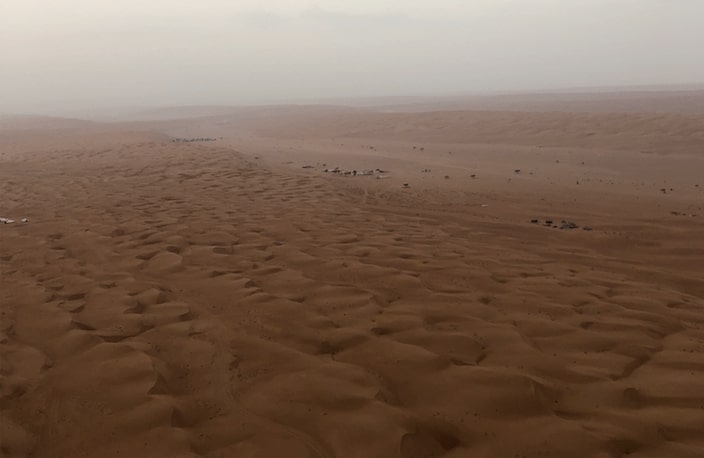Situated in the Eastern Region of Oman, Wahiba Sands, also known as Sharqiya Sands, is a vast expanse of unspoiled beauty that captivates the soul and ignites the imagination. A marvel of nature that sprawls over 12,500 square kilometers, this sea of sand holds stories of centuries within its grains, beckoning travelers from all over the world to delve into its depths. The shifting dunes, shaped by the persistent dance of winds over time, rise and fall like golden waves in a ceaseless desert ocean. Each dune, with its unique contour and height, stands as a monument to nature’s artistic prowess.
The sheer magnetism of Wahiba Sands is not just in its breathtaking landscapes but also in the sensory experience it offers. As you step onto the sands, you can feel the fine grains slide through your fingers, a gentle reminder of time’s passage. The scent of the desert, especially after a rare rain, carries with it the aroma of hidden flora, giving a hint of the life that thrives against all odds in this arid realm. The silence of the desert is occasionally punctuated by the call of a distant bird or the whisper of the wind, serenading visitors into a state of serene reflection. With every sunrise and sunset, the desert paints the sky with hues of red, orange, and purple, offering a mesmerizing display that challenges the boundaries of reality and fantasy. To truly understand the allure of Wahiba Sands is to immerse oneself in its embrace and let its myriad wonders unfold.
Bedouin Culture: A Legacy of the Desert
The nomadic Bedouin tribes have called the desert home for centuries. Their way of life is intricately woven into the fabric of the Wahiba Sands. Visitors are often welcomed into Bedouin tents, where they can sip on traditional Omani coffee, savor local delicacies, and listen to tales of life in the desert. This interaction offers a unique chance to understand the Bedouin ethos – their close relationship with the environment, their remarkable adaptability, and the customs that have been passed down through generations. The hospitality of the Bedouins is legendary, and spending time with them is sure to be a highlight of any trip to the Wahiba Sands.
Flora and Fauna: Life’s Persistence Against the Odds
At first glance, the desert may appear barren, but a closer look reveals an ecosystem teeming with life. Adaptation is the key to survival here. From the desert foxes that have evolved to navigate the challenging terrain to the hardy desert plants that conserve every drop of water, the biodiversity of Wahiba Sands is truly remarkable. A guided tour can help point out the often-overlooked inhabitants of the desert, from beetles that skitter across the dunes to the birds that soar overhead. As the sun sets and the desert cools, nocturnal creatures come out, providing yet another perspective on life in this challenging environment.
Night Skies: A Celestial Canvas
Far from city lights, the Wahiba Sands offers one of the best stargazing experiences in the world. The vast desert sky, unpolluted by artificial light, provides a perfect canvas for the stars, planets, and other celestial bodies. As darkness descends, the Milky Way stretches out in all its glory, and shooting stars seem to streak across the sky with surprising frequency. Whether you’re an amateur astronomer or simply someone who appreciates the beauty of the night sky, laying back on the soft sand and gazing up at the cosmos is an experience that will leave an indelible mark on your soul.


